Marcel Breuer
21st May 1902 – 1st July 1981
Had that bicycle maker possessed a little more vision, he would be a major part of design history – and possibly a very wealthy man. Because today, tubular steel “Breuer chairs” have “been done” in almost every conceivable fashion, and are arguably one of the most popular and recognisable furniture designs on the planet.
Breuer’s odyssey began at the Bauhaus, where he studied and later taught in the 1920s. There, “Lajko,” as he was known to his friends, learned from modern design mentors including Le Corbusier, Mies Van der Rohe and Walter Gropius. Working with these modernist pioneers inspired Breuer to combine art and technology in new ways.
The stunning result appeared in 1925, when Breuer realised his goal of designing the first bent tubular steel chair. The Wassily Chair – which despite some claims was not designed for the artist Wassily Kandinsky – became an instant sensation. More steel-based designs followed, including his famous Laccio tables, stools, cupboards and other pieces Breuer considered “essential designs for modern living”.
The cantilevered steel chair known simply today as the “Breuer Chair” first appeared in 1928 after years of development. Usually featuring a wood and cane seat and seatback, this simple yet iconic design adheres to the strict Bauhaus principle of two sets of structures, one carrying the load and one supporting the body. These chairs were so ahead of their time that they did not reach the peak of their popularity for almost a half-century, becoming modernist must-haves in the 1970s.
In later years, Breuer moved from Eastern Europe to London to New York, taught at Harvard, and eventually turned his focus toward architecture, designing landmark buildings including UNESCO headquarters in Paris, the at The Hague and the Whitney Museum.
He also applied the same principals used in his tubular steel pieces to plywood furniture, creating some elegant and functional new designs. All adhered to his personal philosophy, “Structure is not just a means to a solution. It is also a principle and a passion”. It is that principle and passion that has allowed Marcel Breuer’s designs to endure into the 21st century.

